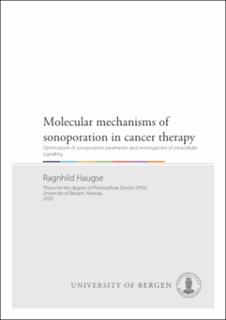| dc.contributor.author | Haugse, Ragnhild | en_US |
| dc.date.accessioned | 2020-06-25T12:15:08Z | |
| dc.date.issued | 2020-06-17 | |
| dc.date.submitted | 2020-06-04T07:31:31.490Z | |
| dc.identifier | container/57/5c/9c/6f/575c9c6f-9e6a-4776-9ba5-25779e6a7f7f | |
| dc.identifier.isbn | 9788230865842 | en_US |
| dc.identifier.isbn | 9788230856123 | en_US |
| dc.identifier.uri | https://hdl.handle.net/1956/22966 | |
| dc.description.abstract | Background: Sonoporation, which is treatment with ultrasound (US) and microbubbles (MB), has shown great potential for enhancing the therapeutic efficacy of chemotherapy in cancer therapy. However, there is still very little consensus regarding the mechanism or optimal experimental and therapeutic parameters. The original assumption was that pore formation in the cell membrane was responsible for the increased uptake of drugs, but it is currently understood that the mechanisms are far more complex. The field combines US physics, MB formulation and physics, (cell) biology, pharmacology, pharmacokinetics and the biodistribution of both drugs and MBs. Hence, there is an almost endless range of experimental parameters and potential bioeffects. The current literature includes a plethora of experimental setups and parameters, which complicates the clinical translation of sonoporation. Aims and methodology: In this thesis, the effects of low-intensity US and MB parameters were investigated in vitro using custom-made ultrasound chambers and correlating commonly used measures as uptakes of impermeable dye (i.e. flow cytometry) and viability to detect intracellular signalling responses to sonoporation in different cell types. Intracellular signalling responses to sonoporation are largely unknown, and their influence on key proteins in important signalling pathways have been elucidated using phosphoflow cytometry. To gain the understanding and translatability of US + MB parameters, three commercially available MB formulations were characterized, and important parameters, such as dose and formulation, were investigated in vitro and the in vivo enhancement of chemotherapy in a mural model of pancreatic ductal adenocarcinoma (PDAC). Results and conclusions: Effective sonoporation was achieved using commercial microbubbles and low-intensity US in the diagnostic range, both in vitro and in vivo. In the low-intensity US regimen, effective sonoporation required MBs, and the efficacy increased as US intensity and MB concentrations increased. The choice of optimal MBs depended on the US parameters used, and must be carefully chosen based on the therapeutic context. The findings in vivo were correlated to those in the in vitro experiments and to simulations on MB behaviour. Sonoporation induced the immediate, transient activation of intracellular signalling (MAPK-kinases; p38, ERK1/2, CREB, STAT3, Akt) as well as changes in the phosphorylation status of the proteins involved in protein translation (i.e. ribosomal protein S6, 4E-BP1 and eIF2α). The intracellular signalling response resembles cellular recovery after pore formation by electroporation and pore-forming toxins. Based on this observation, we hypothesize that sonoporation induces a cellular stress response that is related to the membrane repair and restoration of cellular homeostasis, and it may be exploited therapeutically. Varying responses in different cell types better represent the variability within a tumour, and they indicate that the effects on the tumour microenvironment may be important for sonoporation efficacy. In the present work, cellular stress was induced using low-intensity US below the intensity limit approved for diagnostic imaging, and healthy blood peripheral cells were minimally affected. | en_US |
| dc.language.iso | eng | eng |
| dc.publisher | The University of Bergen | eng |
| dc.relation.haspart | Paper I: Haugse R, Langer A, Gullaksen S-E, Sundoy SM, Gjertsen BT, Kotopoulis S, McCormack E. Intracellular signalling in Key Pathways Is Induced by Treatment with Ultrasound and Microbubbles in a Leukemia Cell Line, but not in Healthy Peripheral Blood Mononuclear Cells. Pharmaceutics 2019, 11(7),319. The article is available at: <a href="http://hdl.handle.net/1956/22965" target="blank">http://hdl.handle.net/1956/22965</a> | en_US |
| dc.relation.haspart | Paper II: Haugse R, Langer A, Murvold ET, Costea DE, Gjertsen BT, Gilja OH, Kotopoulis S and McCormack E. Low-intensity sonoporation induced intracellular signalling of pancreatic cancer cells, fibroblasts and endothelial cells. The article is not available in BORA. | en_US |
| dc.relation.haspart | Paper III: Kotopoulis S, Popa M, Safont MM, Murvold ET, Haugse R, Langer A, Dimcevski G, Lam C, Bjanes TK, Gilja OH, McCormack E. SonoVue® vs Sonazoid™ vs Optison™: Which bubble is best for low intensity sonoporation of pancreatic ductal adenocarcinoma? The article is not available in BORA. | en_US |
| dc.rights | Attribution-NonCommercial (CC BY-NC) | eng |
| dc.rights.uri | https://creativecommons.org/licenses/by-nc/4.0/ | eng |
| dc.title | Molecular mechanisms of sonoporation in cancer therapy : Optimization of sonoporation parameters and investigations of intracellular signalling | en_US |
| dc.type | Doctoral thesis | |
| dc.date.updated | 2020-06-04T07:31:31.490Z | |
| dc.rights.holder | Copyright the Author. | |
| dc.contributor.orcid | https://orcid.org/0000-0001-8793-3097 | |
| fs.unitcode | 13-25-0 | |
| dc.date.embargoenddate | 2022-06-17 | |

